To the 70 anniversary of the Battle of the Dnieper. Soviet offensive on the left bank. Part of 2
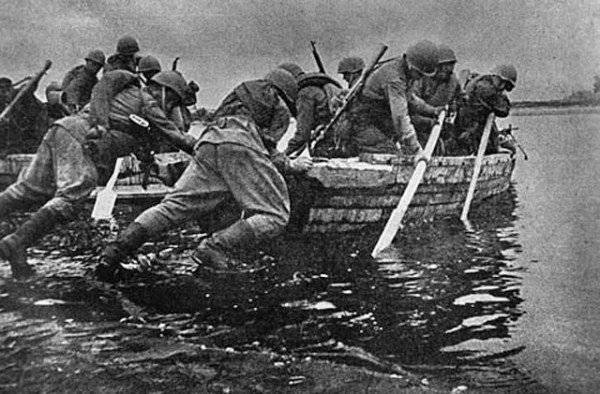
On September 19, a mobile group was formed as part of the Voronezh Front, which included the 3rd Guards tank army under the command of P. S. Rybalko and the 1st Guards Cavalry Corps of V. K. Baranov. On September 20, mobile units launched an offensive in the direction of Pereyaslav-Khmelnitsky. On the night of September 22, advanced groups of the group reached the Dnieper in the areas of Rzhishchev and Veliky Bukrin. The Germans, in the bend of the Dnieper, in the Bukrin area, initially had insignificant forces, so the small motorized infantry units, with the support of the partisans, forced the river. September 23, due to the lack of significant enemy forces in the area, was a convenient time for the Soviet troops to cross over. But due to the extension of the troops to great depths, the lack of ferry facilities for heavy weapons and the lag of artillery, this moment was not fully used. Front-line forces had to conduct heavy fighting on the bridgehead, reflecting the attacks of enemy infantry and tanks, with the support of the Luftwaffe.
The 40 Army of K.S. Moskalenko advanced in the area of Pereyaslav-Khmelnitsky. On the night of September 26, N. E. Chibisova’s 38 Army attempted to force the Dnieper north of Kiev. But the German troops repelled it with strong fire. In the following days, fighting off fierce counterattacks of the enemy, the army of Chibisov captured a small Lutetage bridgehead. Before 10 in October, the 38-I army expanded it along the front to 15 km, in depth by 5-10 km.
I must say that the offensive of the Voronezh Front was accompanied by the use of airborne assault forces. Three airborne brigades, 1, 3, and 5, transferred to the corps under the command of Major General I. I. Zatevakhin were transferred to the front. The total number of corps was 10 thousand people. For the landing, 150 bombers, 180 transport aircraft and 35 landing gliders were identified. Initially, the landing operation was planned to begin on September 21. But because of the problems with the concentration of troops at the Bogodukhovsky aerodrome, the operation could not be started in time. The landing of the 3 and 5 brigade began on the night of September 24. Marines were landed in the areas of Grushevo, Potaptsy, Trostinets, Litvinets, and Kovali in 10-20 km west of the Dnieper. The paratroopers were given the task of preventing the enemy troops from approaching the Bukrin bend of the Dnieper, to ensure the transfer of the front troops.
Due to the poor technical preparation of the operation, problems started already at the landing stage. Landing scattered over a very large area. Part of the assault force landed in the disposition of its troops, even on the left bank, others were thrown into the river, one group deep in the rear of the enemy. Because of the strong anti-aircraft fire, the landing was made from a height not 600-700 meters, and 2 km. This also led to the dispersion of paratroopers. In addition, because of problems with the supply of fuel and the lack of tankers, the planes dropped 25 in the morning on September 4,6 thousand people, and in two brigades there were 6,6 thousand soldiers. The situation was aggravated by errors in the distribution of radio stations between aircraft. At the same time, they lost all four powerful radio stations of the operational group. As a result, there was no communication between headquarters and amphibious groups. The support team was not dropped, so the landing area was not marked off the ground. A further landing was stopped, the remaining one and a half brigades were taken to the reserve. Do not have time to reset and artillery, mortars.
The bulk of the paratroopers, unexpectedly for themselves, was in the center of the enemy troops. The front headquarters made the mistake of finding that there were no German troops in the areas designated for the landing. But there were already parts of the 19-th tank division and the units of the 112-th, 255-th infantry divisions and the 10-th motorized division approached. Instead of tactics of fights from ambushes and strikes against enemy columns on the march, we had to fight in the deployed order of the enemy, which has complete superiority in number and fire weapons. The paratroopers were forced to take an unequal battle, many died. Thus, in a forest area east of the village of Grushevo, a fierce battle was fought by a group of approximately 150 fighters from the 3 airborne brigade. All the paratroopers heroically died, refusing to surrender and destroying a significant number of enemy soldiers.
As a result, the troops suffered heavy losses and could not perform the task entrusted to it. At the same time, the Germans recognized that the Soviet landing force had violated an orderly defense system. The largest landing forces gathered in Kanev Forest - around 600 people, near the village of Chernyshi - 200 fighters, in the Yablonov region there were several groups with a total number of 300 people. The command of the front 26 - 28 September threw three groups into the enemy's rear, trying to figure out the fate of the landing force. They all died.
By October 5, the commander of the 5 Airborne Brigade, Lieutenant Colonel P. M. Sidorchuk, united the scattered, surviving groups into a consolidated brigade (about 1,2 thousand fighters). Having established contacts with the partisans, the paratroopers began to conduct active hostilities. On October 6, the paratroopers established contact with the headquarters and received orders to switch to sabotage actions to disrupt the enemy’s rear. A few days later, airborne ammunition and supplies were adjusted. The Germans, meanwhile, organized an operation to eliminate amphibious groups using armored vehicles. October 12 consolidated brigade was surrounded. In a night battle, paratroopers pierced the encirclement ring and broke through into the Taganchansky forest. They organized sabotage activities, destroying several enemy garrisons. When the Germans again pulled together large forces, trying to encircle and destroy the consolidated landing brigade, the Soviet soldiers made an 50-kilometer-long march to the east. They moved to the Cherkassy forest, connecting with the partisan detachments.
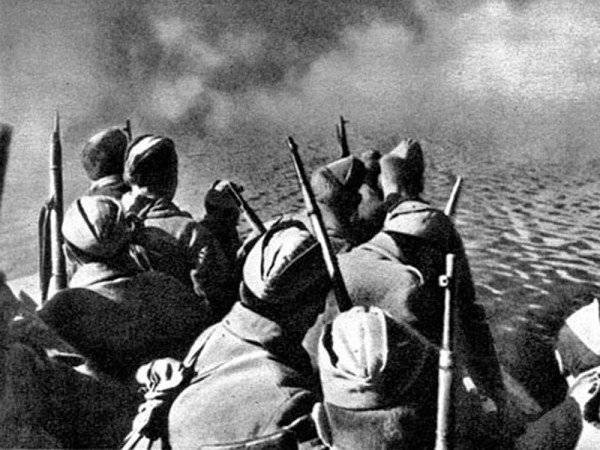
The onset of the Steppe Front. On August 29, the troops of the 5th Guards Tank Army of General P. A. Rotmistrov and the 53rd Army of General I. M. Managarov liberated Lyubotin, opening the way to Poltava. However, Soviet troops came up against serious resistance in the area of Merefa. It was an important railway junction and the main resistance junction, which covered Kharkov from the south. The Germans organized here a strong defense, which was promoted by the river. Mzh. For five days, the 7th Guards Army of General M. S. Shumilov fought hard battles at the turn of the Uda River. Only after the concentration of significant forces of artillery and aviation, the enemy defenses managed to break through. On September 5, Shumilov’s army liberated Merefa. The path to the Dnieper was open. However, it was still necessary to defeat the strong Poltava group of the 8th German army of Veler. In the direction of Poltava and Kremenchug, the most powerful group of the 8th German army retreated, consisting of the 3rd, 47th tank and 11th army corps.
6 September The headquarters slightly changed the direction of the fronts, giving new lines of demarcation. Voronezh Vatutin Front was aimed at Kiev. The Konev Steppe Front had to quickly advance in the general direction of Poltava and Kremenchug, trying not to allow the enemy to create a stable front, to destroy the Poltava and Kremenchug groups. From the Reserve Headquarters, the Steppe Front was handed over to the 37 Army of General MN Sharokhin. From the Voronezh Front, the 5 th Guards Army of General A. S. Zhadov was returned, and the 46 Th Army of VV Glagolev was transferred from the South-Western Front.
In the region of Poltava a particularly bloody battle ensued. Reserves were transferred here — units of the 106 Infantry Division, SS Reich Tank Division. The garrison of Poltava doubled. The Germans were actively carrying out engineering work, created minefields, ditches, barriers, blew up railways and highway bridges. Often went into counterattacks. On the right bank of the Vorskla a strong defensive line was prepared, with numerous gun, mortar and machine gun positions. The city is prepared for all-round defense, stone buildings turned into strong points. The approaches are shot. All bridges and crossings on the river eliminated. Poltava became a powerful knot of resistance, which was supposed to contain the offensive of the Soviet troops.
The left wing of the front, the troops of the 57 and 46 armies, advanced in the direction of Dnepropetrovsk. The troops of the 69 and 7 of the Guards armies advanced in the center, in the direction of Kobeljaki. The right wing of the front - 5-I Guards and 53-I armies, bypassed Poltava from the north and south. But the front had big problems with mobile units - the 5-I Guards Tank Army was set aside for restoration. The 1 th mechanized corps under the command of General M. D. Solomatin advanced on the right flank of the front, but had little equipment.
By the end of September 21, the 53-I Army of Managarov and the 5-I Guards Army of Zhadov reached the east coast of Vorskla. They could not immediately cross the river and free Poltava. 22 September at dawn, the troops of the two armies, in spite of the stubborn resistance of the enemy, forced the river. The soldiers of the 95 Guards Rifle Division and the 84 Rifle Division made their way to Poltava first. They were scouts led by Senior Lieutenant Skachko, as well as Sergeant Mukhin and Private Konshalov. Behind them the assault groups of the 95 Guards, 84 Rifle and 9 Guards Airborne Divisions broke into the city. By the morning of September 23 Poltava was cleared of the forces of the enemy. The city of Russian glory was liberated. People gladly greeted the liberators. The city was badly damaged by the enemy, so in the center of Poltava the Nazis blew up almost all the buildings. Just before the departure, the Germans tried to burn down the school, where they drove the residents along with their children from the nearby houses. But the Soviet soldiers managed to save the doomed people.
The battered German troops retreated to the Dnieper crossings at Kremenchug. Kremenchug was an important communications hub on the left bank and after the loss of Kharkov and Poltava, the German command kept it in every way. There were ferries and a bridgehead, which ensured the withdrawal of troops from the left bank. The Kremenchug bridgehead was created, which was equipped according to the rules of the then military engineering science. Anti-tank ditches were dug at the nearest approaches, minefields and wire barriers were established. To cover the crossing, units of the Reich and Great Germany divisions were sent. The city was concentrated a significant amount of food, stolen good, thousands of people who were going to be driven into slavery.
The crossings at Kremenchuk should have captured the troops of the 5 Guards and 53 Army. September 28 Soviet troops reached the Kremenchug. Two days were fierce battles. September 29 Soviet troops completely cleared Kremenchug from enemy forces. At the same time, the Stavka ordered the main attack in the general direction of Cherkasy, Novo-Ukrainka, Voznesensk, in order to defeat the enemy’s Kirovograd grouping. The left wing of the Steppe Front had to attack in the direction of Pyatikhatka and Krivoy Rog, in order to go into the rear of the Dnepropetrovsk grouping of the enemy.
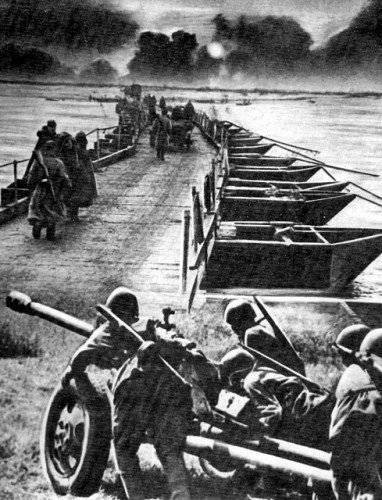
After the capture of Kremenchug, units of the 5-th Guards and 53-th armies immediately began to force the Dnieper. On September 25-26, parts of the Steppe Front captured the first bridgeheads north-west of Verkhnodniprovsk. German troops made continuous counterattacks. The Luftwaffe, taking advantage of the fact that Soviet aviation did not have time to redeploy to new runways, delivered strong blows to our troops and crossings. But the river was forced by Soviet troops on the move and on a wide front. The hopes of the German command that the "Eastern shaft" would become an insurmountable obstacle for the Red Army did not justify themselves.
To force the Dnieper Soviet troops had to use the materials at hand. The terrain was a steppe, there was no forest. On the way to the river, they tried to collect boats, barrels, planks from the destroyed houses. Near the river, in the nearest settlements, barrels, fences, doors, wooden sheds, roofs, etc. were used. Soldiers and commanders showed their original Russian ingenuity and ingenuity. When crossing the river and fierce battles for bridgeheads, soldiers, sergeants, officers showed mass heroism. It should be noted that on the way to the Dnieper, the Soviet soldiers saw many unsightly pictures caused by the German scorched-earth tactics. Soviet soldiers blazed with a fair sense of retribution.
From September 29 to October 10, 1943 of the year, on the bridgeheads of the 37 and 7 of the Guards armies, heavy fighting continued. The German command tried to destroy the Soviet bridgeheads by concentrating against them 4 tank divisions (6, 9, 23, and Dead Head) and one motorized ("Great Germany"). German troops conducted one counterattack after another. In these areas, the Germans managed to create an advantage in armored vehicles (the Soviet troops initially did not have transport means for heavy equipment) and aircraft. Soviet troops were able to hold the bridgehead, all enemy attacks were repulsed. By October 10, the troops of the Steppe Front completely cleared the left bank of the Dnieper from the enemy, captured 5 bridgeheads on the right bank, two of which were of operational importance.
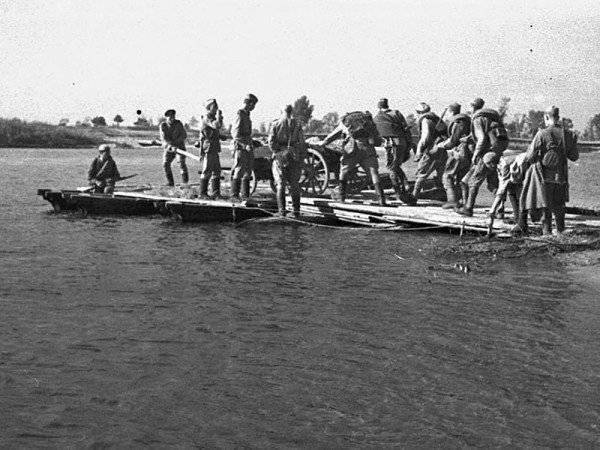
The actions of the South-Western and Southern fronts. The forces of the South-Western Front launched the August 13-16 offensive, but it developed slowly. At the same time, the advance of the troops of the South Front of the Front contributed to the success of the forces of the Southern Front, which went on the offensive on August 18, broke through the Mius-Front, and on August August 30 released Taganrog. September 15 troops of Army Group "South" began to depart in the area of Melitopol. The main efforts of the South-Western Front were concentrated on the Dnepropetrovsk and Zaporizhia directions. The southern front was advancing to the lower reaches of the Dnieper, Crimea.
From 23 to 30 September, the troops of the South-Western Front destroyed the German bridgehead at Dnepropetrovsk. The 6 Army, under the command of Lieutenant General IT T. Shlyomina, forced the Dnieper and occupied two small bridgeheads south of the city. At the same time, the front forces reached Zaporozhye, where the German forces had created a powerful center of resistance. Hitler gave a categorical order to the units of the 1 tank army to hold the Zaporizhia bridgehead at any cost. The German command believed that while Zaporizhia was in their hands, the Red Army would not risk developing an offensive in the bend of the Dnieper and the Sea of Azov.
28 September The Supreme High Command issued an order to the South-Western Front in early October to eliminate the enemy's Zaporizhia bridgehead. The directive emphasized that while the left bank of the Dnieper was not cleared of enemy troops, the Wehrmacht could strike the flank and rear of the Soviet troops. October 10 left flank of the front went on the offensive, striking from the northeast, east and southeast. The offensive involved the 12-I, 8-I armies, part of the forces of the 3-th Guards Army. German troops repeatedly went to counterattacks, using heavy Tiger tanks and assault guns. Four days in the Zaporozhye region were heavy fighting. By the end of October 13, overcoming the fierce resistance of the German troops, the Red Army broke through the enemy defenses. On the night of October, the city was cleared of enemy forces.
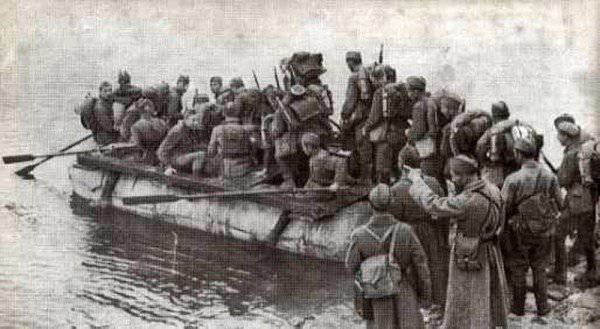
Results
Despite a number of mistakes and all the difficulties faced by the Soviet troops, the Battle of the Dnieper became one of the most ambitious offensive operations of the Red Army and led to significant positive results. The German troops, after the defeat at Kursk, Oryol and Kharkov, on the Mius-front, could not consolidate on the “Eastern shaft” and put themselves in order. The Red Army liberated vast areas with millions of people from the enemy, great economic opportunities that were immediately used to strengthen the military power of the USSR. The German command once again underestimated the strength of the Red Army and the increased skill level of Soviet commanders. German troops were not ready for a powerful blow at once to five Soviet fronts. The Wehrmacht suffered heavy losses in manpower and technology. Germany lost important economic areas that provided it with coal, iron ore, manganese, non-ferrous metals, and food.
Among the mistakes made by the Soviet command, the researchers point out the lack of regular transfer means, especially for heavy machinery, their lack had to be compensated by improvised means. There was a serious lack of air support, Soviet aviation connections did not have time to relocate to new take-off sites. As a result, German aviation caused serious damage to the Soviet troops, making it difficult to transfer troops to the right bank of the Dnieper. The Soviet command planned to crush a significant part of the German forces to the great river, during the "run to the Dnieper". But this task could not be accomplished. German troops had greater mobility, and the advancing fronts were seriously lacking in mobile units. The Soviet tank armies after the Battle of Kursk, when they suffered heavy losses, were in reserve, on re-formation. In mid-September, from the Reserve, Stakes transferred only 3-th Guards Tank Army, but it experienced a serious lack of equipment, especially transport for motorized infantry.
Only Rokossovsky Central Front was able to complete the task of dissecting the defensive orders of the opposing German forces. German defenses in the Central Front offensive line simply collapsed. But in this area, success was not fully utilized. According to Rokossovsky, there were chances to free Kiev by the forces of the Central Front at the first stage of the Battle of the Dnieper. However, the forces of the front redirected to the Gomel sector, and part of its forces transferred to the Voronezh front. Voronezh, Steppe, South-Western fronts attacked mainly due to frontal extrusion of enemy forces. In addition, the Germans themselves retreated everywhere, conducting a "sweep" of the territory. The scorched earth tactics also slowed the pace of the Soviet offensive. It was necessary to tighten the rear.
The Soviet army managed to force the Dnieper on the move. "East" shaft was everywhere broken. By early October, troops of the Central, Voronezh and Steppe Front seized 21 a bridgehead on the right bank of the Dnieper: 7 on the Central Front, 9 on the Voronezh Front and 5 on the Steppe Front. In the offensive zone of the South-Western Front, the 2 bridgehead was captured. All October there were fierce battles on captured bridgeheads. The German command, concentrating significant forces of infantry, tanks and aircraft, tried to knock the Soviet troops out of the river. The Red Army tried to keep captured bridgeheads, as well as to consolidate and expand them. A significant number of bridgeheads did not allow the Germans to concentrate their forces on their elimination. At the same time, their small size forced the Soviet troops to conduct heavy fighting to expand them, in order to prepare for the second stage of the Battle of the Dnieper.
During the first stage of the Battle of the Dnieper, both sides suffered heavy losses. The total losses of the Soviet troops were about 428 thousand people. German total losses - more than 320 thousand people.
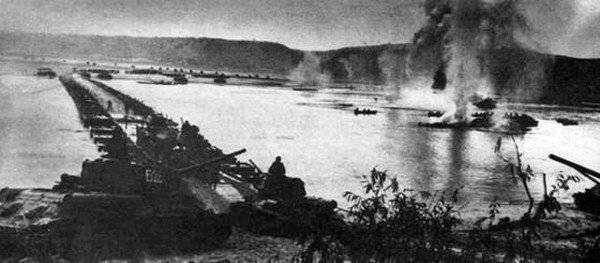
Information